| |
| |
Golden Jubilee |
| |
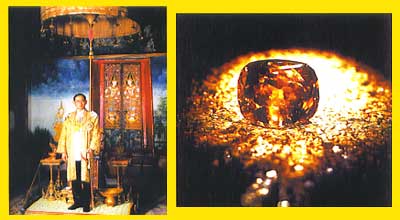 |
|
The
Golden Jubilee is the largest faceted diamond in the world, weighing 545.67
carats in which a yellow-brown cushion shape diamond is now the Crown
Jewels of Thailand. The original stone weighted 755.50 carats and then
was designed by master-cutter Gabi Tolkowsky (He also designed the 273.85-carat
Centenary Diamond, which is the largest D-Flawless diamond in the world.)
who took three years to complete its transformation into the world's largest
fancy diamond. The result was that the cutter could preserve the greatest
possible amount of the weight of the rough diamond in which he was losing
diamond less then 28 per cent. Tolkowsky described the Golden Jubilee's
cut as a "fire rose cushion cut." The color has been graded
as "fancy yellow-brown" by GIA Lab.
|
| |
Left to right King Rama IX of Thailand, The Golden Jubilee |
|
|
|
| |
The
Golden Jubilee is known to have been purchased from De Beers by a Thai
syndicate in 1995". The diamond was then given to King Rama IX of
Thailand in 1997 for his Golden Jubilee - the 50th anniversary of his
coronation. King Rama IX had the Golden Jubilee mounted in his royal scepter.
Prior to this event, the stone was simply known as the Unnamed Brown in
which was found at the Premier mine, South Africa in 1986. |
| |
Cullinan |
|
|
|
| |
The
Star of Africa, a pear shaped diamond weighing 530.20 carats, aka
the Cullinan I. It's called the Cullinan I because it's the largest
of the 9 large stones cut from the Cullinan Diamond. The historic
Cullinan diamond, found in Premier Mine, South Africa in 1905, weighed
an astounding 3,106.75 carats. The Cullinan was cut by Joseph Asscher
and Company of Amsterdam, who examined the enormous crystal for
around six months before determining how to divide it. The Star
of Africa, weighs 530.20 carats, holds the place of 2nd largest
cut diamond in the world and King Edward placed it in the Sovereign's
Royal Scepter.
The Cullinan II is a 317.40 carat cushion cut stone mounted in the
band of the Imperial State Crown. The Cullinan III is a pear-shaped
diamond weighing 94.40 carats, and is in the finial of Queen Mary's
Crown and can be worn with the IV as a pendant-brooch. The Cullinan
IV, a 63.60-carat cushion shape. All are a part of the Crown Jewels,
and they are now on display in the tower of London. |
|
|
| |
Left to right : The Imperial State Crown, The Cullinan
III & IV on brooch, The
Sovereign's Royal Scepter. |
|
| |
|
|
|
|
|
|
| |
Koh - I - Noor |
| |
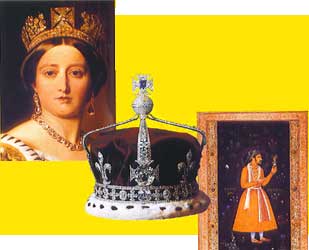 |
|
According
to some sources, the Koh-i-noor diamond was found in the Godavari
River in central India 4,000 years ago. The authentic history of
this jewel begins in the 14 c. when it was reported to be in the
possession of the rajas of Malwa. It later fell into the hands of
Baber, who founded the Mogul dynasty in 1526. During the next two
centuries the diamond was one of the most prized items in the treasure
of the Mogul emperors. Tradition associated with it states that
its owner will rule the world, but that to possess it is dangerous
for any but a woman.
In 1939, Nadir Shah
of Persia invaded India and all of the treasures of the Moguls fell
into his hands except the great diamond. Nadir is believed to have
exclaimed "Koh-i-noor", mountain of light. Later, Ranjit
Singh, the Lion of the Punjab, took the stone and wore it as a decoration.
It was later placed in the Lahore treasury. After the Sikh wars,
it was taken by the East India Company as part of the indemnity
levied in 1849, and was subsequently presented to Queen Victoria. |
| Left to right : Queen Victoria, Queen Mother Crown,
Mogul Emperor |
|
|
|
| |
It
was decided to recut it from its original Indian form, and a member of
the Amsterdam firm of Costar was called to London to cut the stone and
got the oval cut in 108.93 carats. Queen Victoria continued to wear it
as a brooch. The actual Koh-i-Noor can now be seen in the Maltese Cross,
in a crown made for the Queen Mother in 1937, on display at the Tower
of London. |
| |
The Regent |
|
|
| |
Originally
known as the Pitt Diamond, this 410-carat stone was found in India.
In 1710, it is said to have been discovered in the Parteal Mines
on the Kistna River. In 1702, Governor Thomas Pitt of Madras sent
the diamond to England and had it fashioned into a 140.50 carat
cushion-shaped brilliant cut.
In
1717, Thomas Pitt sold the gem to Philip II, Duke of Orleans, then
Regent of France, since that time, it has been known as the Regent
Diamond. It was adorned the Royal Family in many different kinds
of personal ornaments such as It was set in the crown of Crown of
Louis XV in 1 723. Then, it was robbed in 1792, during the Revolution
and in 1797 the great gem was pledged for money that helped Napoleon
in his ride to power. Many of the French Crown Jewels were sold
at auction in 1 887, but the Regent was reserved from the sale and
exhibited at the Louvre among the national treasures. |
|
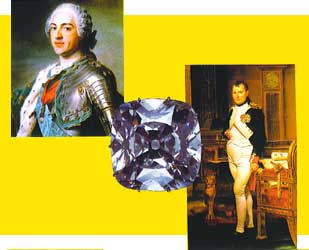 |
|
| |
|
|
Left to right : Louis XV, The
Regen, Napoleon |
| |
The Orloff |
|
|
|
|
|
| |
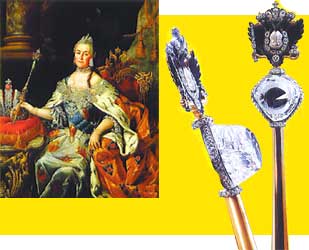 |
|
Some
might say the most outstanding of the treasures held within the
Treasures of the USSR Diamond Fund of the Kremlin is a large diamond
known as the Orloff (sometimes spelt Orlov). A few sources believed
that the Orloff is but a part of the larger Great Mogul and therefore
the same stone which vanished after the pillaging of Delhi in 1739.
The
particulars of the Orloff s story once served as the eye of a Hindu
devotional statue. The man held responsible for its removal was
a French deserter. Persian merchant who then owned the Orloff, found
an eager buyer in Count Gregori Gregorievich Orloff, a Russian nobleman
and army officer who caught the fancy of the Grand Duchess, destined
to become Catherine the Great. The Count paid a purported huge amount
of Dutch florins. Count Orloff sought to rekindle his forlorn romance
with Catherine the Great of Russia by offering her the diamond.
While he failed to regain her affections, Catherine had never wore
the diamond and named the diamond after the Count, and had her jeweler
design the Imperial Scepter incorporating the Orloff. |
|
| |
Left to right : Catherine the Great. Different views of the
Orloff on the Imperial Seepter |
|
|
|
|
|
| |
The Centenary |
|
|
|
|
|
| |
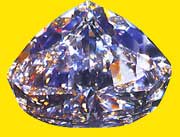 |
|
The
100-year anniversary of De Beers Consolidated Mines coincided with
the fortuitous discovery of an extraordinary diamond rough. At its
centennial banquet, the De Beers chairman announced the recovery
of "a diamond of 599 carats which is perfect in color - indeed,
it is one of the largest top color diamonds ever found. Naturally,
it will be called the 'Centenary Diamond.'
The
Centenary diamond was found at South Africa's Premier Mine on July
17, 1986. It took Gabi Tolkowsky three years to transform the stone
into the largest modern-cut flawless diamond. The Centenary has
75 facets on top, 89 on the bottom and 83 on the girdle, for a total
of 247. The amazing result was achieved using a combination of some
of the oldest cutting methods and the most sophisticated technology.
The 'Centenary' diamond weighs 273.85 carats, and is set into the
British Crown Jewels. The 'Centenary' diamond was presented at the
Tower of London in 1991, where it is on permanent display. |
| |
|
|
|
| |
Hope |
|
|
|
|
|
| |
The
history of the stone that was eventually named the Hope diamond
began when the French merchant traveler, Jean-Baptist Tavernier,
purchased a 112.5 carat diamond. This diamond, which was most likely
from the Kollur mine in Golconda, India, was somewhat triangular
in shape and crudely cut. Its color was described by Tavernier as
a "beautiful violet."
Tavernier sold the diamond to King Louis XIV of France in 1668.
In 1673 the stone was recut by Sieur Pitau, the court jeweler, resulting
in a 67 so carat stone. In the royal inventories, its color was
described as an intense steely-blue. It was set in gold and suspended
on a neck ribbon that the king wore on ceremonial occasions.
|
|
| Left to right : The Hope Diamond, Marie Antoinette,
Photo from the formal presentation of the Hope Diamnd to the Smithsonian |
In 1791, after an attempt by Louis XVI and Marie Antoinette to flee
France, the jewels of the French Royal Treasury were turned over
to the government. The diamond was stolen during the French Revolution
in September of 1792. In 1812 a deep blue diamond described by John
Francillion was documented as being in the possession of London
diamond merchant, Daniel Eliason who sold the diamond to the well-known
Henry Philip Hope, the man from whom the diamond takes its name.
In 1912 Catier sold the Hope diamond to Mrs. Evalyn Walsh McLean,
of Washington D.C. Sometime later it became the pendant on a diamond
necklace as we know it today. Mrs. McLean's family then suffered
a series of catastrophes: her only child was accidentally killed,
the family broke up, Mrs. McLean lost her money, and then committed
suicide in 1947.
Harry Winston Inc. of New York City purchased Mrs. McLean's entire
jewelry collection, including the Hope diamond, from her estate
in 1949. On November 10, 1958, Harry Winston donated the Hope diamond
to the Smithsonian Institution in Washington, and almost immediately
the great blue stone became its premier attraction.
|
|
| |
|
|
|
|
|
 |

